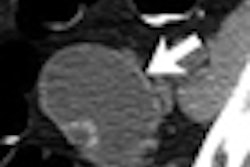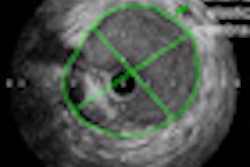Ten-year outcomes data from the Rotterdam coronary artery calcium (CAC) study underscore the prognostic power of adding CAC to a traditional risk stratification method. New results in the Journal of the American College of Cardiology show that CAC scores frequently change the risk category for future coronary events in asymptomatic individuals.
CAC was particularly effective in altering the risk scores for those at intermediate risk, wrote Suzette Elias-Smale, MD, from Erasmus Medical Center in Rotterdam, the Netherlands, along with colleagues from Rotterdam; Groningen, the Netherlands; and Basel, Switzerland (JACC, October 19, 2010, Vol. 56:17, pp. 1408-1414).
"Additional testing for atherosclerosis is proposed to be most useful if applied to the intermediate-risk category (10% to 20% [coronary heart disease] risk in 10 years), in which treatment decisions are uncertain," they wrote. Nevertheless, long-term reclassification percentages for CAC and empirically derived CAC cutoff values used for reclassifying patients are lacking, they added.
Framingham + CAC
The study sought to clarify the prognostic value of the Framingham score plus CAC score over time, following 2,028 asymptomatic individuals (mean age, 69.6 years ± 6.2; 43% male) who participated by undergoing electron-beam CT (EBCT) for CAC scoring.
The subjects' baseline exam was completed between 1990 and 1993, followed by a second exam between 1993 and 1995 and a third between 1997 and 1999. "From 1997 onward, participants through 85 years of age were invited to undergo EBCT scanning of the heart to perform CAC scoring," the team wrote.
Participants were classified into 10-year risk categories -- low (< 10%), intermediate (10% to 20%), or high (> 20%) -- based on the Framingham refitted risk model. The risk model was then extended by the addition of CAC, and the percentage of patients reclassified was recorded.
Empirical data for CAC were used to derive risk in individuals at intermediate risk. The empirically derived cutoff value at which individuals moved from the intermediate-risk to the high-risk group was 615 Agatston units (AU), and the value was 50 AU for the intermediate- to the low-risk group. Scoring was performed using software that defined calcification as two or more adjacent pixels 130 HU or greater.
Data were available for a total of 2,292 participants, of whom 252 were excluded for a history of coronary artery disease at the time of EBCT scanning, leaving 2,040 asymptomatic subjects for analysis in the study.
A total of 502 individuals died during the mean follow-up period of 9.2 years, and there were a total of 135 hard coronary events in the cohort, including 81 nonfatal myocardial infarctions and 54 fatal coronary heart disease (CHD) events, the authors reported. The mean calcium score was 84 AU (25th to 75th percentile: 8 to 382 AU).
Most intermediate-risk patients reclassified
The results showed that adding CAC to the Framingham risk model leads to substantial reclassification between CHD risk categories, especially in persons at intermediate Framingham risk.
"In this group, 52% of men and women were reclassified, all into more accurate risk categories," the authors wrote. "CAC values above 615 or below 50 Agatston units were found appropriate to reclassify persons into high or low risk, respectively."
Fewer patients at the high or low end of Framingham risk were reclassified following the addition of calcium scoring. "Overall, 12% of persons in the low-risk group and 34% of persons in the high-risk group were reclassified," the authors reported. "These percentages are comparable to those in the recent [Multi-Ethnic Study of Atherosclerosis (MESA)], which reported 11% reclassification in the low-risk group and 36% reclassification in the high-risk group."
For example, in men at low Framingham risk, 15% moved to the intermediate-risk group, but only two were reclassified as high risk. In men at high risk, 28% moved down to intermediate risk and 5% to low risk. In women at high risk, 36% moved to intermediate risk and 3% to low risk.
Another measure that showed better stratification with the addition of CAC was the Weibull model that the authors used to assess risk. Compared with the Framingham refitted model, adding coronary calcium significantly improved the fit of the Weibull model (likelihood ratio chi-square increase: 36.4; p < 0.001). In addition, the c-statistic improved significantly from 0.72 to 0.76, "indicating better average discriminative ability of the model including coronary calcium," the authors wrote.
Adding C-reactive protein results did not significantly improve the results of either the Framingham risk or Framingham plus calcium score model.
And reclassification percentages were much higher in the intermediate-risk group compared to adding the ankle brachial index to risk assessment. In a recent meta-analysis, only 4% of men and 10% of women at intermediate risk were reclassified after adding ankle brachial index to a traditional risk model, the authors noted. Other studies have shown an effect of CAC testing on risk assessment without showing reclassification percentages, they noted.
"These results support the findings of the MESA study, published earlier this year, which studied 6,814 patients over nearly six years," Elias-Smale and colleagues wrote. That study logged 115 adverse events in individuals originally classified as intermediate risk based on traditional risk factors. A total of 41% of those events were in people who were reclassified as high risk with the addition of CAC, while 13% moved from the intermediate-risk to the low-risk category.
The authors said the new study was noteworthy for its long follow-up period, but that more research is needed. In particular, "our empirically derived upper cutoff value of 615 AU seems to be higher than the commonly used cutoff values of 400 AU, whereas our lower cutoff value of 50 AU seems to be lower than the commonly used cutoff of 100 AU," they wrote. The cutoff values need to be validated in other large, population-based studies, they stated.
"In a general population of elderly patients at intermediate CHD risk, CAC scoring is a powerful method to reclassify persons into more appropriate risk categories," the authors concluded. "On the basis of CAC testing, more than 50% of an asymptomatic older population at intermediate risk was reclassified as having either low or high risk of hard CHD events."
By Eric Barnes
AuntMinnie.com staff writer
October 14, 2010
Related Reading
CTA screening study shows soft-plaque risk in police, October 4, 2010
SHAPE II task force revising cardiac risk guidelines, August 17, 2010
Coronary calcium usually ignored on chest CT, August 12, 2010
Coronary calcium score doesn't help predict risk in low-risk men, June 7, 2010
CT equivalent to IVUS for culprit plaque detection, December 4, 2008
Copyright © 2010 AuntMinnie.com



















